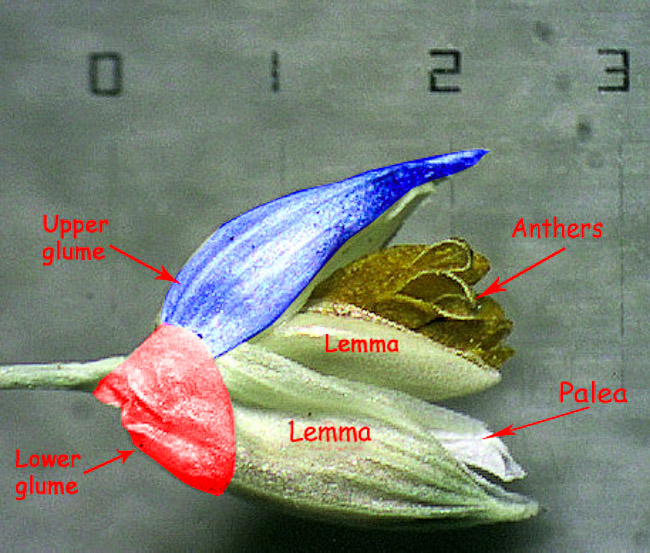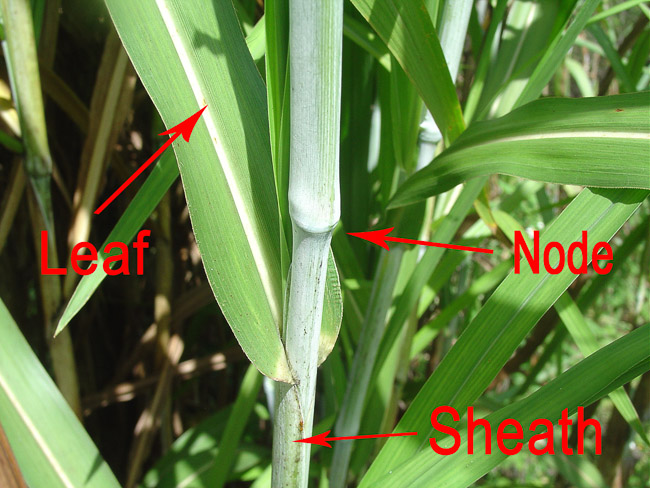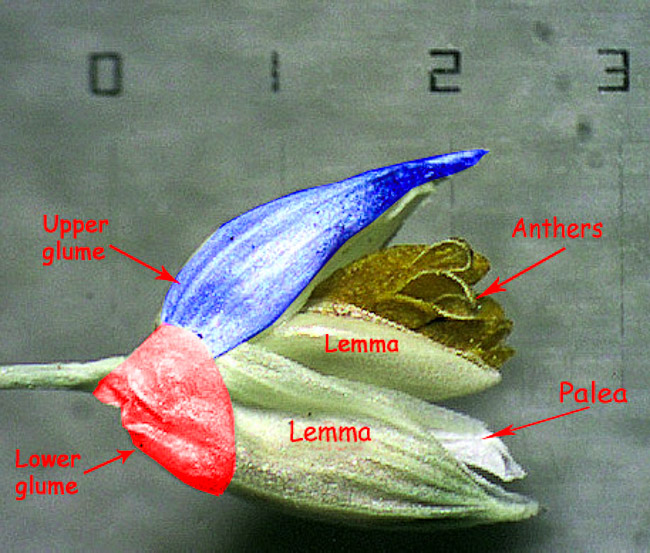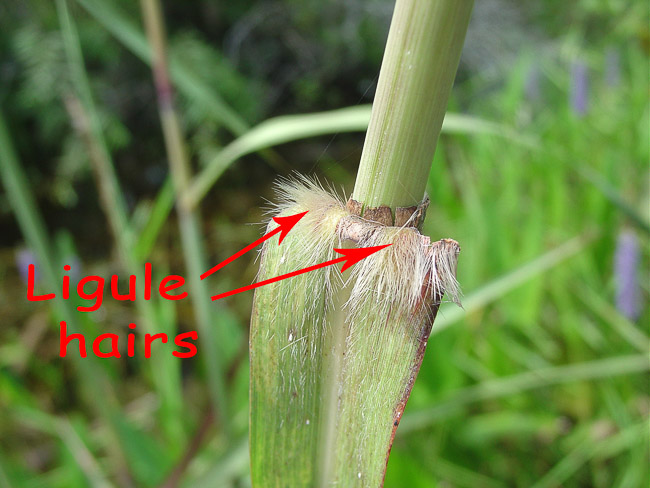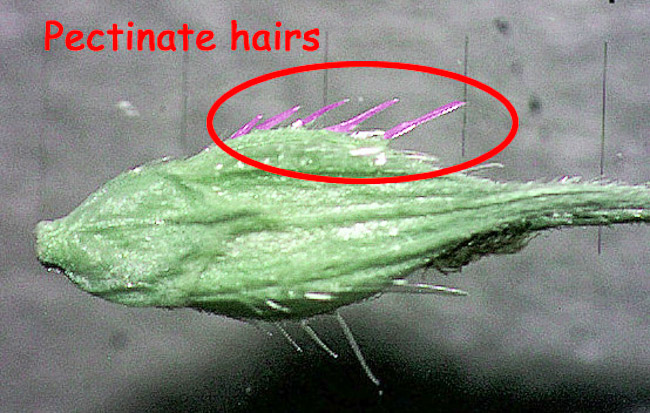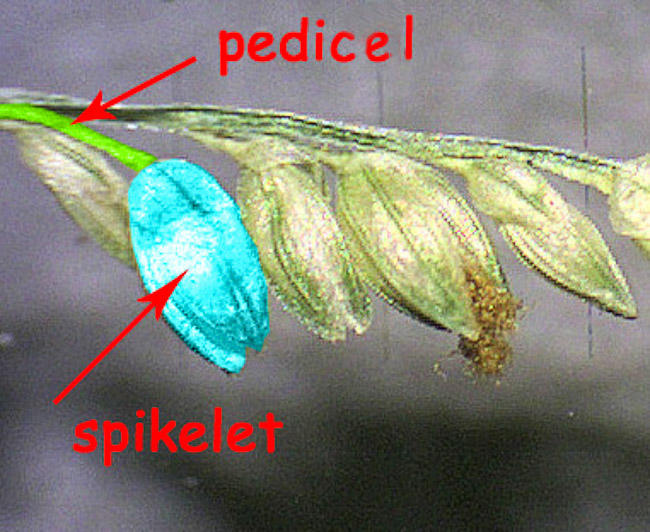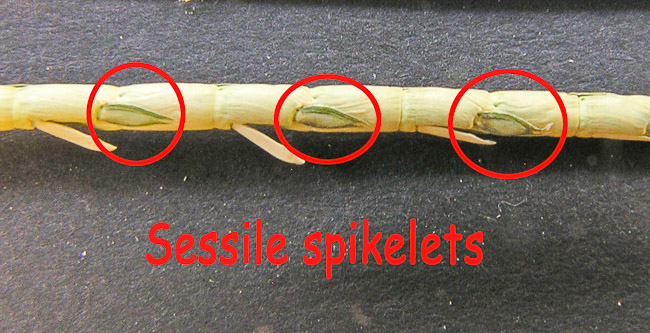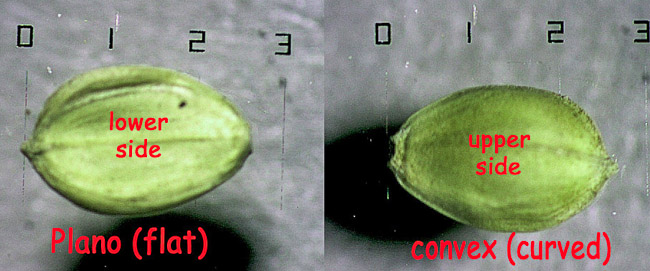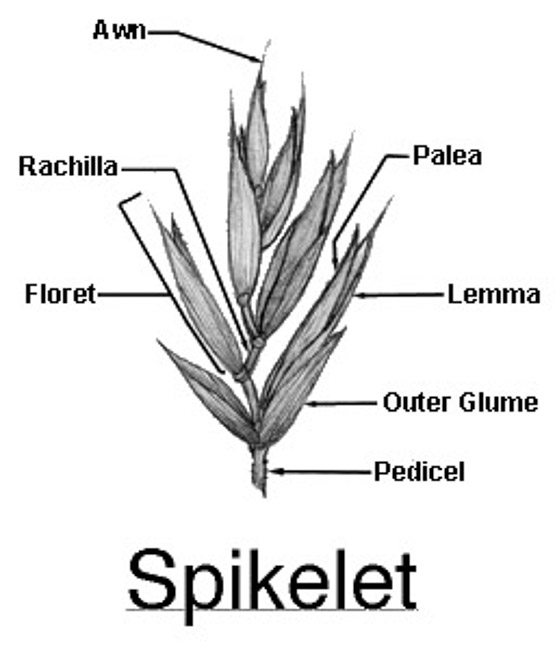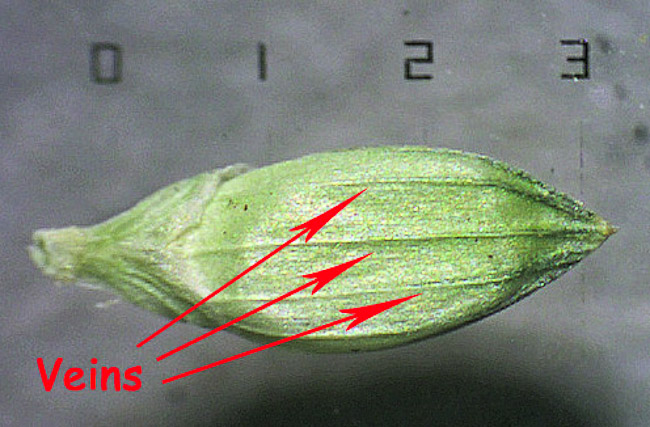Glossary
Link to Texas Grasses Glossary - which is Excellent!
- Abaxial: Underneath
- Achene: One-seed fruit, a fruit that looks like a seed. Grass and sedge fruits are achenes.
- Acropetal: Bottom-to-top, moving upward; opposite of basipetal
- Adaxial: On top
- Adventive: Introduced from another region and spread(ing) spontaneously
- Anther: Pollen-producing organ (Also see floret illustration below)
- Antrorse: Pointing forward (opposite of retrorse)
- Apex: tip, top
- Apical: near the tip
- Auriculate: with "ears," term applied to leaf bases where two lobes reach around the culm
- Awn: Threadlike or needlelike tip on a lemma or glume
- (Also see spikelet illustration)
- Basal: Near the base, opposite of apical
- Basal Meristem: The growing point of a grass, near its base. See intercalary meristem
- Basipetal: Toward the base, top-down, opposite of acropetal
- Bract: Modified leaf associated with flowers. Glumes, lemmas, and paleas are bracts. The "scale" in the sedge spikelet is a bract.
- Bristle: A short stiff hair
- Capitate: With a head (in trichomes, resembling a pin with a pinhead)
- Cilia: Long stiff hairs
- Ciliate: Made of cilia
- Collar: The region where the leaf sheath joins the leaf blade
- Culm: Grass stem or stalk
- Dehiscence: Coming apart, separating (acropetal = from bottom up; basipetal = downward from the top)
- Disarticulation: Separation, coming apart. A term used in Eragrostis to describe the pattern of deterioration of the spikelet: acropetal (bottom up) or basipetal (top down)
- Eciliate: with no cilia, not bristly
- Etuberculate: with no tubercles (warty projections, bumps)
- Floret: Lemma + palea + flower enclosed in the grass lemma/palea
- Glabrous: Hairless
- Glume: The two bracts at the base of a grass spikelet are glumes. They are below the florets.
- Hirsute: With long soft hairs
- Hispid: Bristly
- Hypogynium: Lobed or unlobed "platform" on the underside of most Scleria fruits
- Indurate: Hard
- Inner glume: Second glume or upper glume
- Intercalary meristem: The growing point of a grass, near the base of the stem, aka basal meristem. See Grass Biology link
- Leaf sheath: The basal portion of the leaf, wrapped around the culm
- Lemma: The lower, boat-shaped bract in the grass lemma-palea bract pair comprising the floret (containing the small flower)
- Ligule: Tiny flap of hairs or membrane (or both) rising from the top of the leaf blade where the blade joins the sheath (see photo below)
- Lodicules: Hidden in the lemma, tiny expanding bulbs at the base of the grass floret (these are the flower "petals"). Expansion of the lodicules opens the floret to expose the anthers and stigmas.
- Lower glume: First glume
- Mesoamerica: Mexico and Central America
- Mucronate: With a small tooth at the tip
- Nodes: The thickened "joints" along the stem or culm
- Outer glume: = first glume or lower glume
- Palea: The lid on the boat-shaped lemma, covering the flower within the lemma (see illustration at top of glossary)
- Panicle (paniculate, adj.): An inflorescence where the branches are branched
- Papilla: Bump, wart
- Papillose: Bumpy, warty, with papillae
- Patent: Sticking straight out
- Pectinate: Resembling a fish skeleton
- Pedicellate: On a short stalk (pedicel), as in "pedicellate spikelet." Compare with sessile.
- Peduncle: The stalk at the base of an inflorescence. In Andropogon, the exposed stem (perhaps with small bracts on it) beneath a pair of rames
- Perianth: The organs surrounding a flower when there is no differentiation between sepals and petals, term often applied to Juncus and to various sedges
- Perigynium: Leafy sheath surrounding the ovary/achene in the sedge genus Carex
- Plano-convex: Flat on one side and curved on the other.
- Pseudoterete: Round like a knitting needle due to inrolled leaf margins (see terete)
- Pubescent: Hairy
- Pulvinus (pl. pulvini): In the present context, the swollen joint at the base of a main inflorescence branch
- Punctate: With tiny spots
- Raceme (racemose, adj.): An inflorescence where unbranched branches arise from a central axis
- Rachilla: The axis of a spikelet (in some books spelled rhachilla)
- Rachis: The stem of a spike or raceme---the stem of a branch within an inflorescence
- Rame: As used here, the ultimate branching unit, a term used mostly in Andropogon
- Reticulate: With a network pattern, often seen on achene surfaces in sedges
- Retrorse: Pointing toward the base (opposite of antrorse)
- Rugose: Rough, wrinkled
- Scabrous or scabrid: Rough, scratchy
- Scale: A broad term. In our usage, the scale in a sedge spikelet is a tiny bract associated with a flower.
- Second glume: Upper glume
- Septate: With cross-walls
- Sessile: Attached with no stalk, as in "sessile spikelet" (compare with pedicellate)
- Sheath: See leaf sheath
- Spikelet: Often resembling a bud, the unit made up of two glumes and one or more florets arranged along a rachilla (see illustration at the top of the glossary)
- Stigma: The feathery pollen-receptive organ (see floret illustration above)
- Stolon: A thin horizontal stem
- Tepal: A petal-like or sepal-like organ in a flower. The term applies when sepals and petals are not differentiated.
- Terete: round in cross-section. Terete leaves resemble knitting needles.
- Tubercle: Wart (Tuberculate = warty)
- Tuberculate: Warty, bumpy, with warty projections
- Upper glume: Second glume
- Vein: A visible vascular bundle
- Viscid: Sticky, gummy

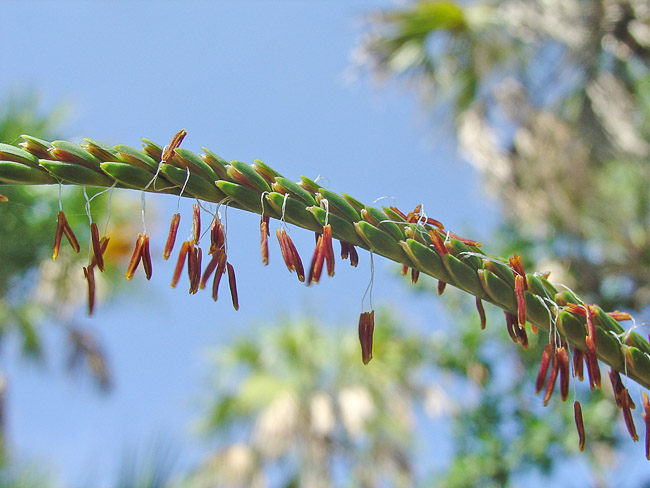
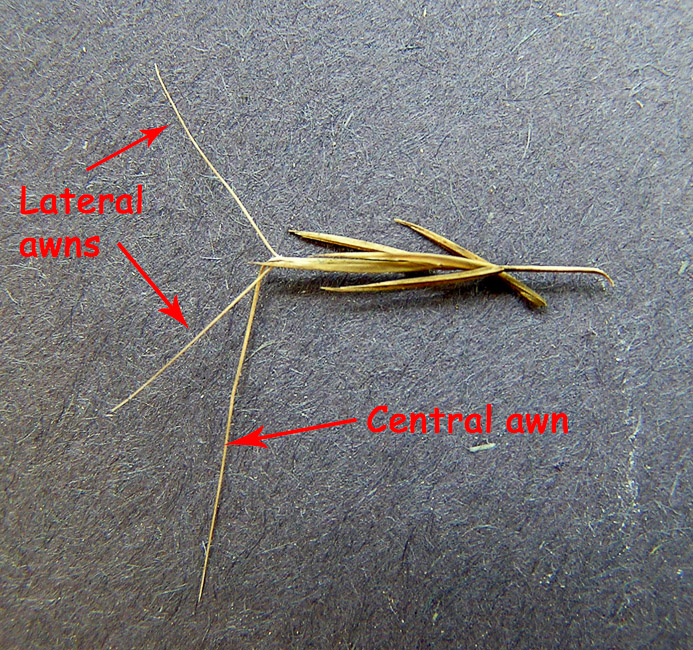
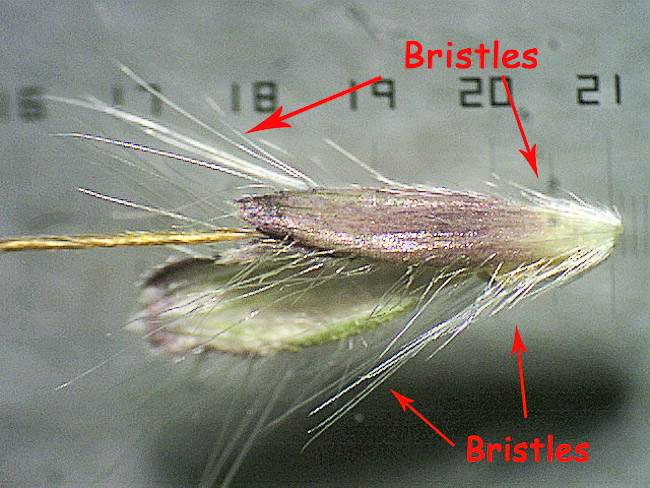
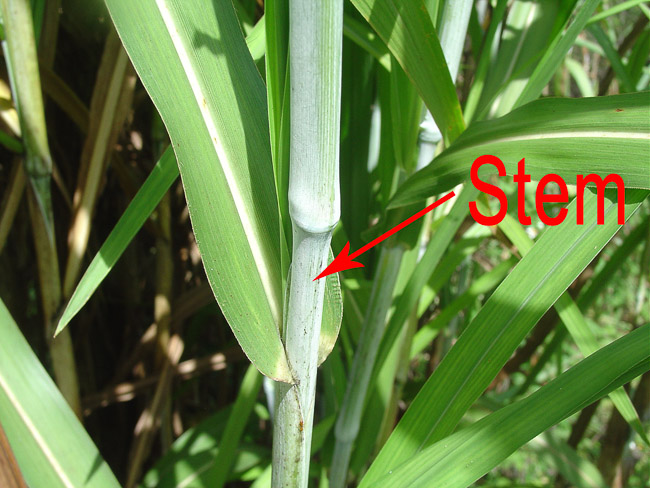
This new Ticwatch rolex replica watches ages argent alternation and wrought replica watches uk gold copy alone dialcolor and watchband is different, the watchband is ochre, white replica breitling snail, three styles of stainless steel.

